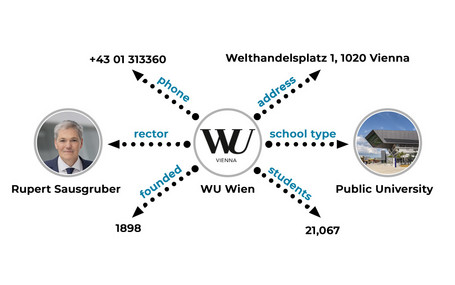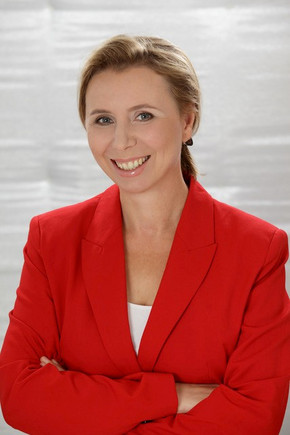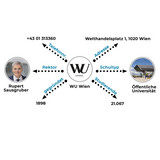When AI systems learn to understand
Marta Sabou has won a prestigious grant from the Vienna Science, Research and Technology Fund (WWTF) for research on AI knowledge graphs.
We use them every day without even realizing it: knowledge graphs. They are behind search engines, digital assistants, social media platforms, or online shops that suggest products by recognizing links between our interests. But as yet, their full potential remains untapped, for example for medical applications. What happens when machines learn to understand these knowledge networks?

Behind the scenes: What are knowledge graphs?
When we search for “WU Vienna” in a search engine, we not only get links to websites but also a curated collection of facts – the year when the university was founded (1898), its current Rector, the number of students. All these pieces of information are linked to each other within a knowledge graph. These structures help computers not only to store knowledge but also to connect entities semantically – in other words, to “understand” the relationships between data (see the example in the image on the left).
In many fields of research, such as medicine, large amounts of complex data are organized in the form of such graphs. The potential of these large collections of data is enormous: for example, the connections between genes, diseases, and drugs could reveal clues for finding new active ingredients or alternative uses for existing drugs – a process that normally requires years of intensive laboratory work and expensive experiments. So far, however, artificial intelligence (AI) systems have only been able to capture this knowledge to a limited extent. Why is that?
Logic vs. learning: The two worlds of AI
Sabou explains: “In AI research, two different worlds collide” – and these two worlds correspond to reasoning and learning, the two aspects of intelligence. Symbolic AI represents the reasoning side: It works based on clearly defined knowledge and logical rules – as in a knowledge graph. It can draw complex conclusions but relies on information that is stated in explicit terms. Sub-symbolic AI, which includes machine learning and neural networks, represents the learning aspect and works very differently: It recognizes patterns in large amounts of data, but it does not recognize the logic behind them. This also includes large language models (for example those powering chatbots such as ChatGPT), which identify linguistic patterns in existing texts and, on this basis, generate new texts – without (fully) understanding their meaning.
Knowledge graph embeddings (KGEs) bridge the gap between these two worlds. They can adapt the graph structure of knowledge graphs and turn them into mathematical vectors so that machines can work with the knowledge they represent. Or, as Marta Sabou describes it, tongue in cheek, “A knowledge graph goes in – vectors come out.” So far, however, KGEs only capture part of the information which is represented in a knowledge graph.

Marta Sabou heads the WU Institute for Data, Process and Knowledge Management.
The DORSET project: Groundwork for promising applications
The DORSET project was funded as part of the WWTF’s highly competitive basic research call on information and communication technology, being one of the 12 projects funded from the 84 proposals that were initially submitted. In the project, WU researchers Marta Sabou, Majlinda Llugiqi, and Fajar Ekaputra work with colleagues from TU Wien (Katja Hose, Emanuel Sallinger, and their teams) to optimize the interplay between knowledge graphs and knowledge graph embeddings. The goal is to improve machine learning so that computers can fully understand complex knowledge networks and derive new insights from them.
The potential applications are very broad in scope – from drug development and personalized medicine to optimizing the power grid. Sabou describes the work in DORSET as basic research that would later enable such applications. “Assuming the toaster is the application, we’re currently still working on providing the electricity, so to speak,” she says.
Congratulations to Marta Sabou and her team on receiving this grant!


![[Translate to English:] Oliver Vettori](/fileadmin/wu/_processed_/f/5/csm_Vettori_7960_Harald_Krischanz_cd9ba6d4dd.jpg)

